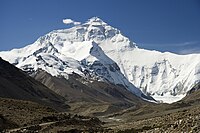
Photo from wikipedia
A bacterial strain, designated S9-5T, was isolated from moraine samples collected from the north slope of Mount Everest at an altitude of 5 500 m above sea level. A polyphasic study confirmed… Click to show full abstract
A bacterial strain, designated S9-5T, was isolated from moraine samples collected from the north slope of Mount Everest at an altitude of 5 500 m above sea level. A polyphasic study confirmed the affiliation of the strain with the genus Sphingomonas. Strain S9-5T was an aerobic, Gram-stain-negative, non-spore-forming, non-motile and rod-shaped bacterium that could grow at 10-40 °C, pH 5-8 and with 0-9 % (w/v) NaCl. Q-10 was its predominant respiratory menaquinone. Diphosphatidylglycerol, phosphatidylglycerol, phosphatidylethanolamine, an unidentified phospholipid, an unidentified aminophospholipid and eight unidentified lipids comprised the polar lipids of strain S9-5T. Its major fatty acids were summed feature 8 (C18 : 1 ω7c and/or C18 : 1 ω6c) and C16 : 0. The G+C content was 65.75mol%. Phylogenetic analysis based on 16S rRNA sequences showed that strain S9-5T was phylogenetically closely related to Sphingomonas panaciterrae DCY91T (98.17 %), Sphingomonas olei K-1-16T (98.11 %) and Sphingomonas mucosissima DSM 17494T (97.39 %). The average nucleotide identity values among strain S9-5T and Sphingomonas panaciterrae DCY91T, Sphingomonas olei K-1-16T and Sphingomonas mucosissima DSM 17494T were 78.82, 78.87 and 78.29 %, respectively. Based on the morphological, physiological and chemotaxonomic data, strain S9-5T (=JCM 34750T=GDMCC 1.2714T) should represent a novel species of the genus Sphingomonas, for which we propose the name Sphingomonas radiodurans sp. nov.
Journal Title: International journal of systematic and evolutionary microbiology
Year Published: 2022
Link to full text (if available)
Share on Social Media: Sign Up to like & get
recommendations!